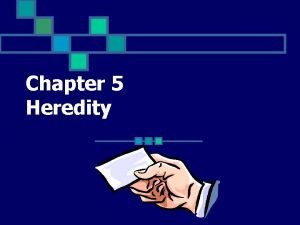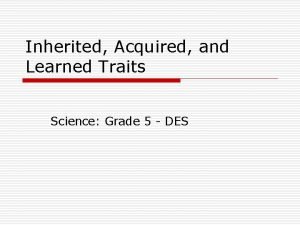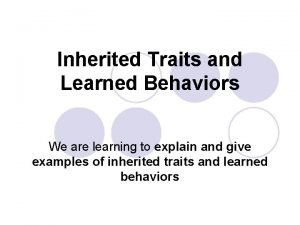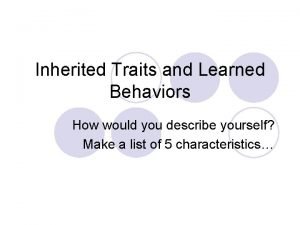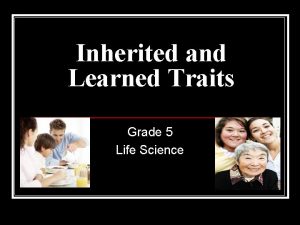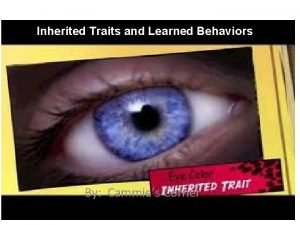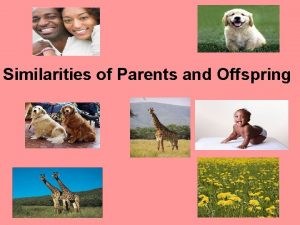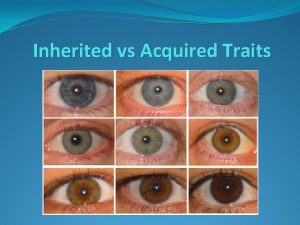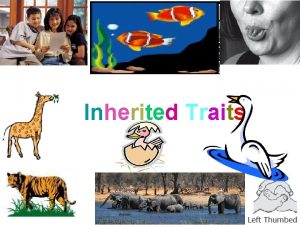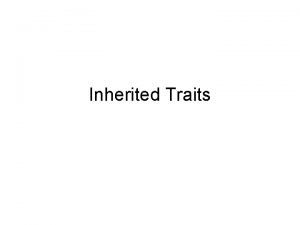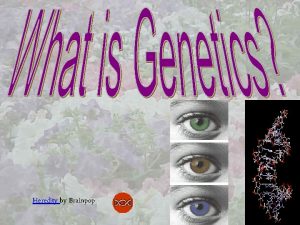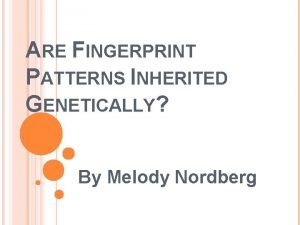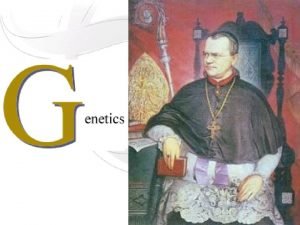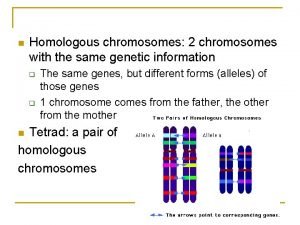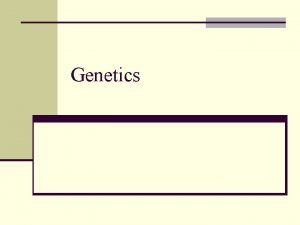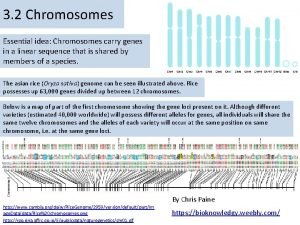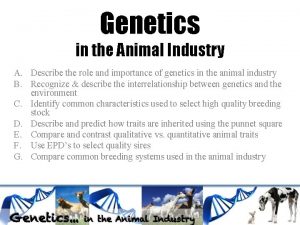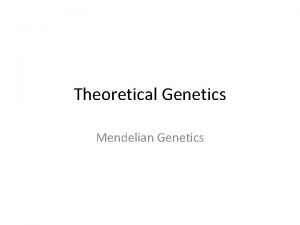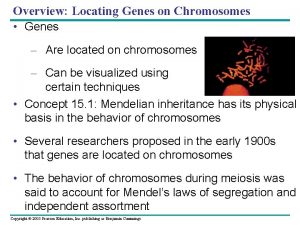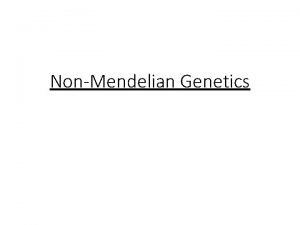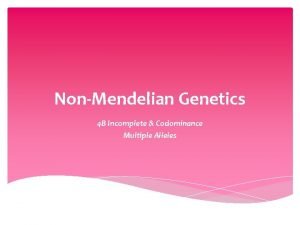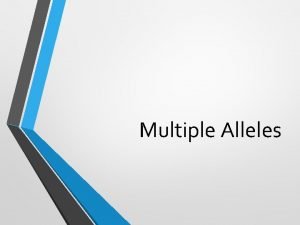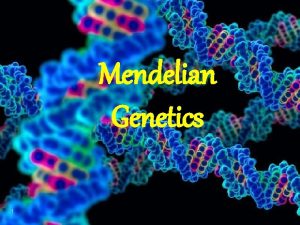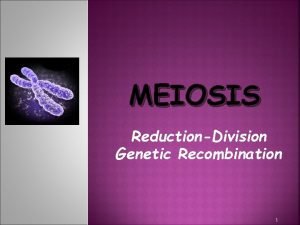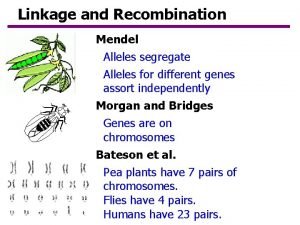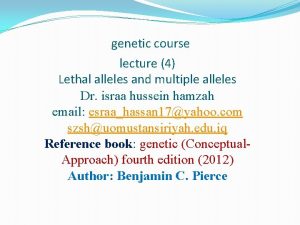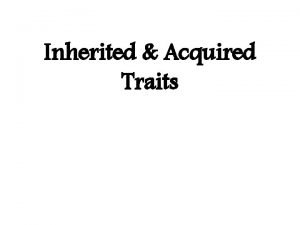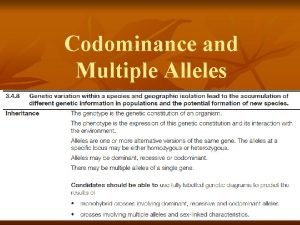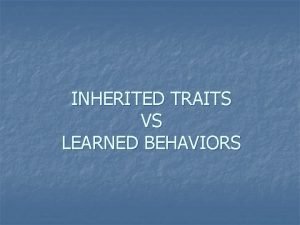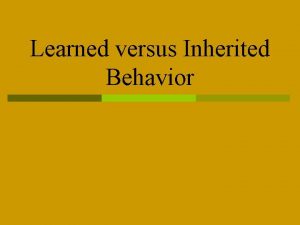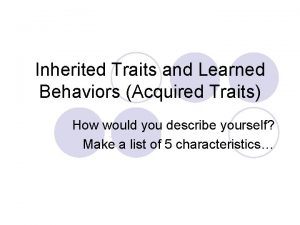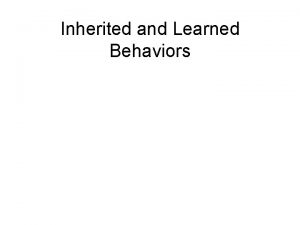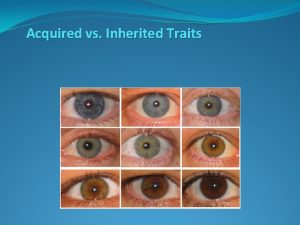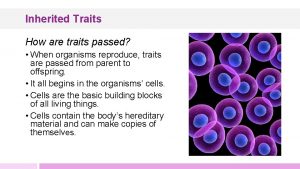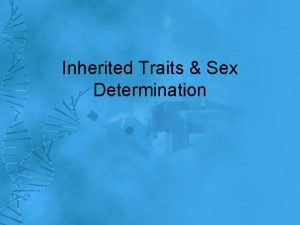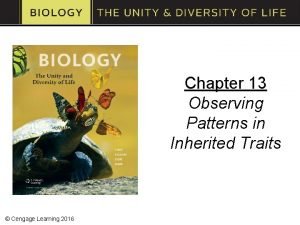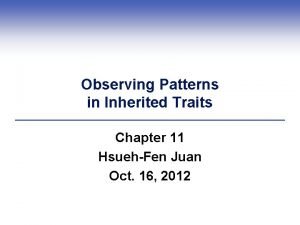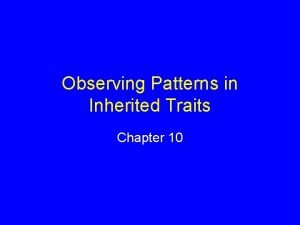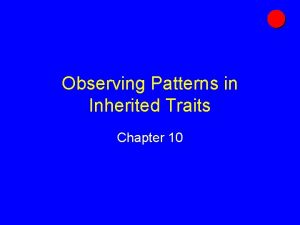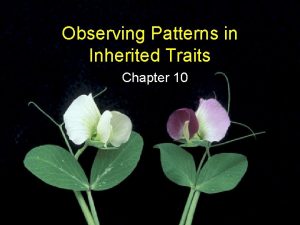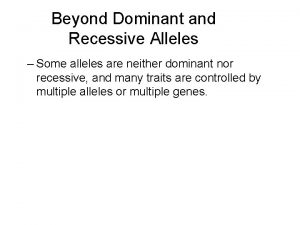Patterns in Inherited Traits Chapter 13 Alleles and

































- Slides: 33

Patterns in Inherited Traits Chapter 13

Alleles and Traits • Blending inheritance • Example: Black and white horse will produce _____offspring • Failed to explain how traits disappear over several generations and then _________unaltered generations later • Charles Darwin did not accept this idea • Gregor Mendel (__________) • Started breeding thousands of ____________ • Kept detailed record of how traits passed from one __________to the next • Began to formulate how _________works

Mendel’s Experiments • Garden pea plant is ____-fertilizing • The flowers produce male and female _______ • The experiments • Controlled the pairings between individuals, by removing __________, with specific traits and observed traits of their ____________ • _______fertilized plants and collected _______ • Recorded traits of new pea plants

Mendel’s Experiments • Started with garden pea plants that “bred true” for a particular trait _________________________ • Cross-fertilized pea plants with different traits and offspring appeared in __________________ • Concluded (correctly) that hereditary information is passed in discrete units

Inheritance in modern terms • Locus: ________________________ • Homozygous: ______________________ • Heterozygous: ______________________ • Hybrids are _______offspring of a cross between individuals that breed true for different forms of a trait • Dominant: Effect masks that of a recessive allele paired with it • represented by italic _______letters • Recessive: Effect is masked by a dominant allele paired with it • represented by italic ___________letters • Genotype: _______________________ • Phenotype: _________________



Allele distribution into gametes • A homozygous dominant pea plant with two alleles (____) has purple flowers, and a homozygous recessive pea plant with two alleles (___) has white flowers • If these _______plants are crossed (PP × pp), all offspring will be ___________ • All __________(F 1) offspring will be heterozygous • Genotype = _______ • Phenotype = _____________

DNA replication meiosis I 2 1 meiosis II 3 gametes (P) gametes (p) zygote (Pp)

Punnet square • A grid used to predict the _______ and _________ outcome of a cross male gametes female gametes

Testcross • _________________________ • An individual that has a dominant trait (but an unknown genotype [PP/Pp]) is crossed with one that is homozygous recessive_____ • Results?

Monohybrid cross • Breeding experiment in which individuals identically __________for _______gene are crossed (Pp×Pp) • Frequency of traits among offspring in the ________ offers information about the dominance relationship between the alleles • First generation = _______ • Second generation = ____ • Results? (Ratio, %)

Mendel’s Seven Pea Plant Traits

Monohybrid cross • https: //www. youtube. com/watch? v=EYYc 7 z 4 y. X 38

Law of segregation • The 3: 1 phenotype ratios in F 2 offspring of monohybrid crosses became the basis of ______________ • _______cells carry pairs of genes on each pair of _________________ • The two genes of each pair are _______from each other during meiosis so that they end up on ______ gametes

Dihybrid cross • Individuals __________for alleles of _______genes (dihybrids) are crossed, and the traits of the offspring are observed • Frequency of traits among the _______offers information about the ______relationships between the paired alleles

Dihybrid cross • One parent plant that breeds true for purple flowers and tall stems (______) is crossed with one that breeds true for white flowers and short stems (____) • Each plant makes only one type of gamete (____) • All F 1 offspring will be dihybrids (____) and have purple flowers and tall stems Punnett square • PT×pt

Dihybrid cross • The result of two F 1 plants crossing: a dihybrid cross (Pp. Tt × Pp. Tt) • Four types of gametes can combine in sixteen possible ways Punnett square

Dihybrid cross • In F 2 plants, four phenotypes result in a ratio of ______ • • _________________________________ • Go back and check results!

Law of Independent Assortment • Mendel discovered the 9: 3: 3: 1 ratio in his dihybrid experiments • Each trait still kept its individual 3: 1 ratio • Each trait sorted into gametes _______of other traits • During meiosis, members of a pair of genes on homologous chromosomes get distributed into gametes independently of other gene pairs

Contribution of Crossovers • How two genes get sorted into gametes depends on if they are found on same chromosome • Random assortment • Genes on one chromosome assort into gametes independent of genes on other chromosomes • Linkage group – all genes on a chromosome • Genes that are far apart on a chromosome tend to assort into gametes independently • Genes very close together on a chromosome are linked • They do not assort independently because crossing over rarely happens between them

Patterns of Inheritance • Simple/Complete dominance • A dominant allele fully masks the expression of a recessive one • Other patterns of inheritance are not so simple: • • Codominance Incomplete dominance Epistasis Pleiotropy

Codominance • Two alleles that are both fully expressed in heterozygous individuals • Multiple allele systems – gene for which three or more alleles persist in a population • Example: an ABO gene for blood type, human hair/eye color.

Codominance • Which two of the three alleles of the ABO gene you have determines your blood type • The A and the B allele are codominant when paired • Genotype AB = blood type AB • The O allele is recessive when paired with either A or B • Genotype AA or AO = blood type A • Genotype BB or BO= blood type B • Genotype OO = blood type O

Genotype: AA or AO Phenotype: A AB BB or BO OO AB B O

Incomplete dominance • One allele is not fully dominant over another • The heterozygous phenotype is between the two homozygous phenotypes (example: red×white=pink) • In snapdragons, one allele (R) encodes an enzyme that makes a red pigment, and allele (r) makes no pigment • RR = red; Rr = pink; rr = white • A cross between two pink (Rr × Rr) yields red, pink, and white in a 1: 2: 1 ratio

Epistasis • The effect in which a trait is influenced by the products of multiple genes • Example: Fur color in dogs • B=_____, b=______ • E=colour in fur, e=reduced colour in fur

Pleiotropy • _________________________ • Mutations in pleiotropic genes are associated with complex genetic disorders • Sickle-cell anaemia: a severe hereditary form of anemia (deficiency of red blood cells) in which a mutated form of ________distorts the red blood cells into a crescent shape at low oxygen levels • Cystic fibrosis: a hereditary disorder affecting the ________. It causes the production of abnormally thick _____, leading to the blockage of the pancreatic ducts, intestines, and bronchi and often resulting in ____________. • Marfan syndrome: a hereditary disorder of __________, resulting in abnormally long and thin digits and also frequently in optical and cardiovascular defects

Environment and Phenotype • Epigenetic research is revealing that environment can influence phenotype • Some examples of environmental effects • • _______________________________ ____________

Short tandem repeats • Some genes have regions of DNA in which a series of two to six nucleotides is repeated hundreds or thousands of times in a row • Example: 12 alleles of homeotic gene that influence face length in dogs • __________________________

Continuous variation • Some traits appear in two or three forms • Example: _____________________ • Others occur in a range of small differences • Example: _____________________ • The more genes and environmental factors that influence a trait, the more continuous the variation • If a trait varies continuously, it will have ________ curve

Cystic fibrosis • Most common fatal genetic disorder in the U. S. • Most CF patients live no more than ________ • The CFTR gene encodes a protein • Protein moves chloride ions out of ____________ • Binds disease-causing bacteria • Occurs in people _________for a mutated allele of CFTR gene (___________) • The allele of CF has a 3 base pair deletion • Called ΔF 508 because protein is missing the normal 508 th amino acid • People with CF inherit 2 copies of ΔF 508 • The deletion causes mucus to accumulate, making breathing difficult

 An organism's inherited combination of alleles
An organism's inherited combination of alleles Acquired traits in animals
Acquired traits in animals Inherited behavior examples
Inherited behavior examples Learned behavior and inherited traits
Learned behavior and inherited traits Inherited traits and learned behaviors 5th grade
Inherited traits and learned behaviors 5th grade Behavioral trait
Behavioral trait Similarities with parents
Similarities with parents Acquired traits of a dog
Acquired traits of a dog What is a inherited trait
What is a inherited trait What inherited traits do elephants have
What inherited traits do elephants have Character traits brainpop
Character traits brainpop Are fingerprint patterns inherited
Are fingerprint patterns inherited Chromosomes and alleles
Chromosomes and alleles Homologous pairs
Homologous pairs Mendelian inheritance pattern
Mendelian inheritance pattern Multiple alleles
Multiple alleles Bill nye genes worksheet answers
Bill nye genes worksheet answers Mass spectrometry
Mass spectrometry X videos
X videos Inheritance of quantitative traits
Inheritance of quantitative traits Qualitative traits vs quantitative traits
Qualitative traits vs quantitative traits Qualitative traits vs quantitative traits
Qualitative traits vs quantitative traits Sickle cell anemia genotype and phenotype
Sickle cell anemia genotype and phenotype Tt x tt punnett square
Tt x tt punnett square Blood punnett square
Blood punnett square Where are alleles located
Where are alleles located Codominance
Codominance Codominance alleles
Codominance alleles Multiple alleles genotypes
Multiple alleles genotypes Ao+ blood type
Ao+ blood type When do alleles segregate during meiosis
When do alleles segregate during meiosis Sister vs non sister chromatids
Sister vs non sister chromatids Parental vs recombinant
Parental vs recombinant Lethal alleles definition
Lethal alleles definition
